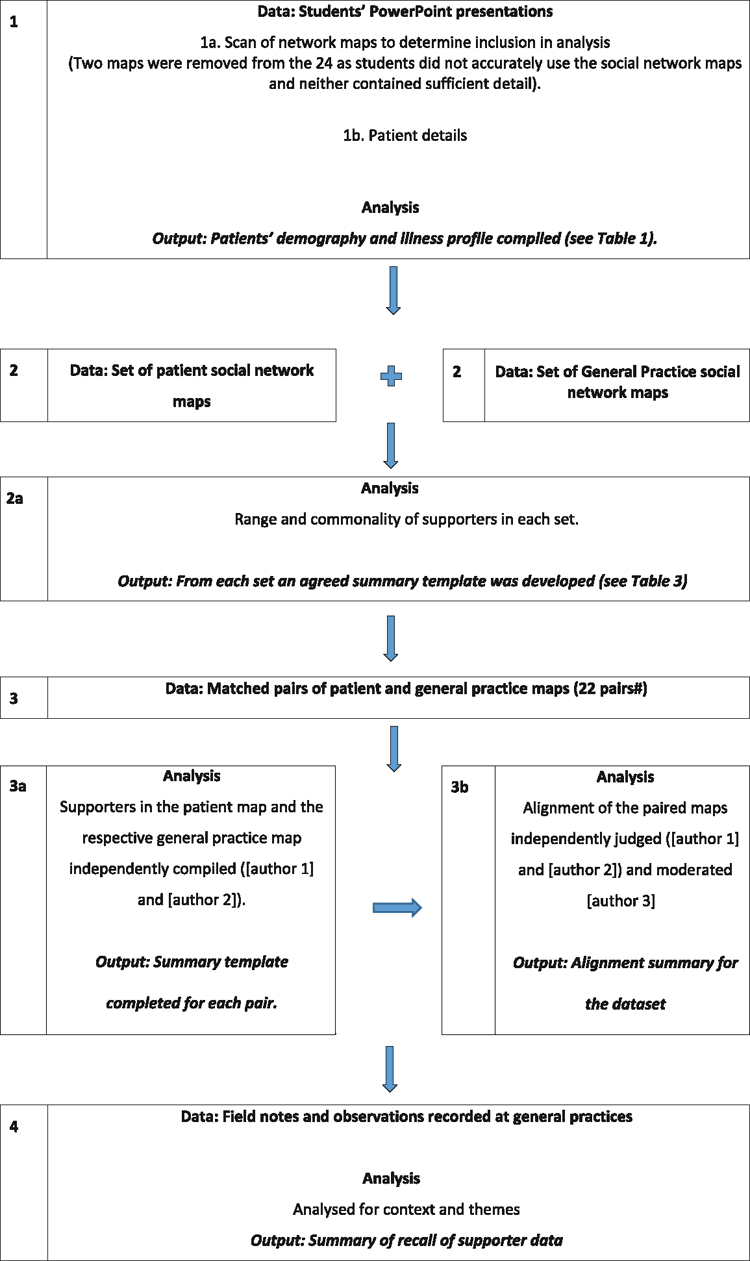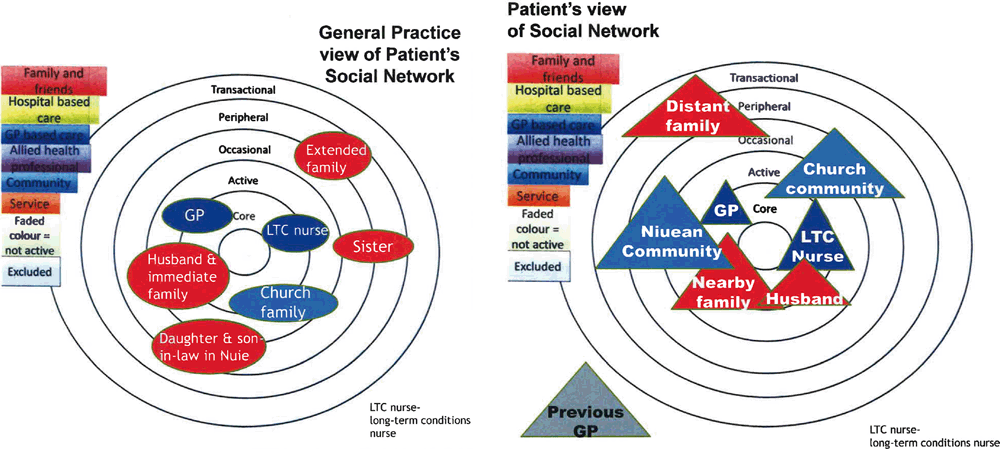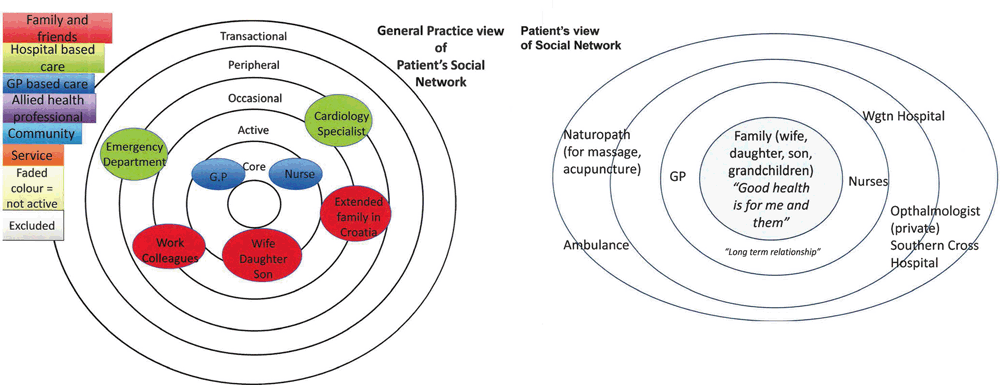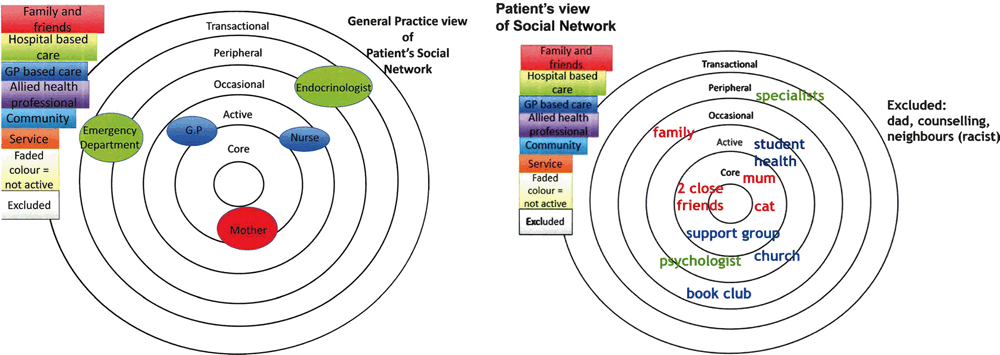General practice and patients’ views of the social networks of patients with multimorbidity
Eileen McKinlay 1 , Jessica Young 2 , Ben Gray 21 Department of Primary Health Care and General Practice, University of Otago, Wellington, New Zealand
2 Department of General Practice and Rural Health, University of Otago, New Zealand
Correspondence to: Eileen McKinlay, Department of Primary Health Care and General Practice, University of Otago, Wellington 6242, New Zealand. Email: eileen.mckinlay@otago.ac.nz
Journal of Primary Health Care 10(3) 258-266 https://doi.org/10.1071/HC17050
Published: 13 July 2018
Journal Compilation © Royal New Zealand College of General Practitioners 2018.
This is an open access article licensed under a Creative Commons Attribution-NonCommercial-NoDerivatives 4.0 International License.
Abstract
INTRODUCTION: For patients with multimorbidity to live well, they need the support of not only health professionals but family, friends and organisations. These social networks provide support, potentially enabling the formation of a Community of Clinical Practice approach to multimorbidity care.
AIM: This study aimed to explore general practice knowledge of the social networks of patients with multimorbidity.
METHODS: Social network maps were completed by both patients and general practice. The social network maps of 22 patients with multimorbidity were compared with corresponding social network maps completed by general practice staff.
RESULTS: In 60% (13/22) of the patients, general practice staff held a high or moderate knowledge of individual patients’ social networks. Information on social networks was recalled from staff memory and not systematically recorded in patients’ electronic health records.
DISCUSSION: Social network information is not routinely collected, recorded or used by general practice to understand the support available to patients with multimorbidity. General practice could take an active role in coordinating social network supporters for certain patient groups with complex multimorbidity. For these groups, there is value in systematically recording and regularly updating their social network information for general practice to use as part of a coordinated Community of Clinical Practice.
KEYWORDS: Communities of clinical practice; general practice; multimorbidity; patients; social networks
| WHAT GAP THIS FILLS |
| What is already known: Patients with multimorbidity have social networks including family, friends, community and health professionals. Social network supporters are an effective source of patient self-management support. |
| What this study adds: General practice can accurately identify the social network supporters of approximately 60% of patients with multimorbidity. This information is not systemically recorded in the Electronic Health Record and not used to coordinate support or bolster patient self-management. |
Introduction
Health is defined as the ‘ability to adapt and to self-manage in the face of social, physical and emotional challenges’.1 This definition is relevant for the health of patients with long-term conditions, including patients with multimorbidity.2 However, the burden of self-care is considerable for these patients,3–6 and if they are to live well, self-manage and thus be ‘healthy’, they need more support than health professionals alone can provide.7–9
Social support networks are essential for people living with long-term conditions.10 These networks are self-defined and typically include family, friends, community-based supporters and organisations.11–13 Ideally, social networks are dynamic and respond to patients’ changing health needs9 by boosting self-management strategies14 or by undertaking on their behalf, illness work, everyday work and emotional work.12 Although health professionals believe they are important in providing care for people with long-term conditions,15 patients value them for a discrete range of actions such as providing access to medications and for information and monitoring.16 In contrast, patients perceive 85% of the support they need is given by social networks of family, friends and community organisations.16
Some social networks include general practice and other health professionals.17,18 These networks are akin to Communities of Clinical Practice (CoCP), whereby a group of people, both professional and lay, commit to providing support for particular patients.11,19–21 General practice teams believe they are the health-care anchor to coordinate care for patients with long-term conditions.22–25 As such, they are expected to know a lot about patients with multimorbidity, particularly when these patients are enrolled in a formal multimorbidity programme.7,15,26 Despite this, little is known of how much general practice or individual staff members know about the social networks of support for patients with multimorbidity.27
This study aimed to explore general practice knowledge about the social networks of individual patients with multimorbidity by comparing what they know with the patient’s own view of their social network.
Context of research
Social network theory and tools
Various theoretical and methodological approaches are used to investigate social support networks, including Social Network Theory and Communities of Practice Theory.9,12,13,16,28 Social Network Theory allows a ‘broader consideration of all the resources available to help support someone with a long-term condition’.9 This broad consideration of support aligns with the CoCP model proposed by Egan and Jaye,19 an adaptation of Wenger’s Community of Practice.29 CoCPs can also include student-learners who join temporarily in pursuit of their education.18,21,30
Social network researchers often use mapping tools for people to record their supporters, including patients with long-term conditions or multimorbidity.8,9,12,16 Mapping tools typically include a template with concentric circles indicating the relative importance of supporters to the person, who is in the centre. Some tools have colour-coded groupings of supporters and can also indicate people who have been excluded.18,21,30 An adapted mapping tool31 has been found to enhance student learning regarding people with multimorbidity.30
Models of New Zealand (NZ) general practice care for multimorbidity
General practice service delivery models for patients with multimorbidity vary internationally.32,33 NZ has had the CarePlus multimorbidity programme since 2002, with a government subsidy to reduce general practice patient co-payments. The programme supports people with multimorbidity to seek 3-monthly, generally nurse-led, proactive health care and fosters self-management support, ideally accompanied by a personalised care plan.34 More recently, and since this study was undertaken, the introduction of the Health Care Home model into NZ general practice has widened the focus on long-term condition management with the aim of having clearer care plans, a workforce with expanded roles and integrated care for patients with complex needs.35
Context of data collection
The General Practice component of the NZ medical degree includes a long-term conditions management module. In the module delivered by the University of Otago, Wellington, students visit patients with multimorbidity who are recruited by primary health-care nurses from local general practices. Nurses purposefully recruit patients from the patients they work with most closely, who they judge will fulfil the module learning objectives. These patients are usually enrolled in CarePlus or a similar multimorbidity programme. Student pairs undertake a home visit and gather brief demographic and illness profile data, and then focus on asking patients about their experiences of having multimorbidity, what matters most (regarding life and wellbeing) and who supports them to live well.36 They are also asked to ‘…use the social network mapping tool to prompt the patient to talk about who is involved in their support and who they rely on most for their wellbeing. Ask the patient to complete the tool - they may want to do this themselves or you may need to help them’. Student pairs then develop a PowerPoint presentation (Microsoft Corporation, Redmond, WA, USA) including patient demographics, illness profile and the social network map.
In 2015, half of the annual intake of fourth year medical students into the University of Otago Wellington programme (48 students or 24 pairs) and primary healthcare nurses from four general practices (one university student-health, two suburban and one central-city) took part in this study. Ethical approval was given by the University of Otago (No: 12/223).
Methods
Mixed methods were used. Students’ PowerPoint presentations (Microsoft Corporation) were retained until the end of the teaching year when patients’ demographic and illness profiles were compiled and patients’ social network maps assembled. Then, general practices who had recruited the patients were asked to complete a fresh social network map for each patient by recording on the network map: who is involved in the patient’s support and who does the patient rely on most for their wellbeing. As a practical measure, in three of the four practices, the nurse who had recruited the patients completed the social network map. In the fourth practice, the practice nurse and general practitioner who were most involved with the patients completed their maps. All the general practice maps were treated the same way in the analysis, irrespective of who completed the maps. Field notes and observations were kept about how the staff completed the maps. During completion of the general practice maps, a researcher sat alongside the staff member(s), observed the process and took notes of what was said and the process adopted to recall the network information.
Data analysis
Typically, social network analysis involves a mixed-methods analysis of quantitative and qualitative data.37 In this study, the analysis followed a defined sequence (Figure 1). Summary categories of supporters were family, friends and community supporters, and health and other professionals; this was similar to categories developed in other social network research.8 Alignment of general practice and patient social networks was judged to be high when E. McKinlay and J. Young agreed that most individuals or organisations were identified by both patient and the general practice; moderate when half were similarly identified; and low when less than half were similarly identified. When E. McKinlay and J. Young did not initially agree, this was discussed and consensus reached. B. Gray independently reviewed the pairs of maps judged as moderate.
Results
This section describes: patient characteristics; social network supporters; degree of social network map alignment (patient and general practice); and general practice recall of supporter data.
Patient characteristics
Participants had a wide range of co-occurring conditions and, typical of people with multimorbidity, many were aged <65 years (Table 1).38
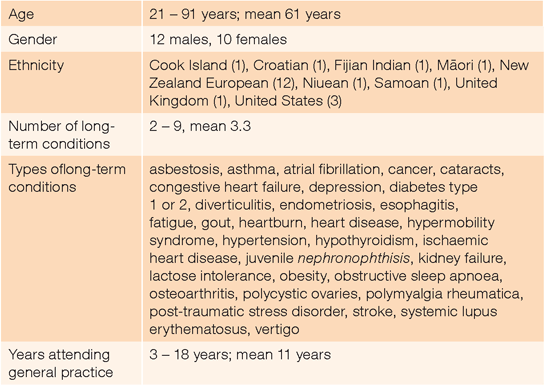
|
Social network supporters
Table 2 shows that most patients recorded diverse social network maps, including supporters in each of the three categories, with up to 14 (mean 8.2) individuals or organisations identified. General practice recorded comprehensive maps for each patient with up to 11 (mean 6.9) individuals or organisations identified. In eight instances, general practices recorded more individuals or organisations than the patients. These tended to be suburban practices where patients had been enrolled for many years.
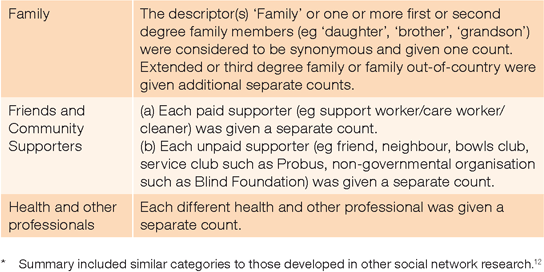
|
Within the three categories, there was a wide range of support (Table 3). The patients were more likely to record family, friends and community supporters. Pets, food suppliers and recreational interests were noted by patients and not recorded by general practice. General practice recorded a higher number and wider range of health professionals.
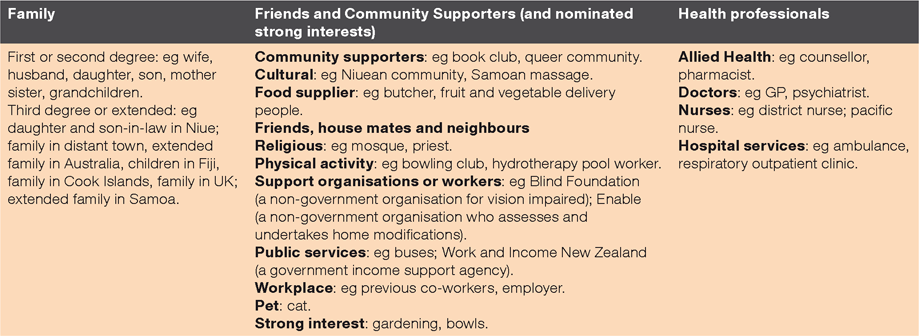
|
Degree of social network map alignment
The degree of alignment in the pairs of social network maps (patient’s view and general practice view) was High for 4 of 22 pairs (18%); Moderate for 9 of 22 pairs (41%); and Low for 9 of 22 pairs (41%). Examples of maps showing the three different levels of alignment are shown in Figures 2–4.
General practice recall of supporter data
General practice staff actively recalled from memory what they knew of each patient and their social network and recorded this information on the map. Most also attempted to look up additional information from the patient’s electronic health record (EHR). Each commented (some with frustration) there was no straightforward way to do this because there are no designated fields in the EHR to record this information. They also noted it was not possible to tell if social network information had or had not been recorded and if it had been, where it was located. Some looked in several different fields and most times could not find the information. Some also attempted to retrieve social network information from the EHR daily consultation notes field, but this proved impossible as staff could not recall dates when information may have been written, with the daily consultation notes not searchable by keyword.
Discussion
This study showed that general practices have substantial knowledge of the social networks of their patients with multimorbidity, with a high or moderate amount of knowledge in 60% of the chosen patients and more limited information recalled for the remaining 40%. Because students were going to interview patients, general practices likely recruited patients they knew well, perhaps because of involvement in a formal multimorbidity programme. All patients had attended the practices for at least 3 years and some for considerably longer.
Given most support provided to patients with long-term conditions is by family, friends and community supporters,16 there are opportunities for general practice to work with social network supporters to provide more comprehensive support for patients with complex multimorbidity.11,19,21 When general practice is aware of these supporters, they could take a role in actively encouraging patients to draw on their help, or actively coordinate supporters, thereby promoting self-management.11,21 Involving social network supporters in boosting patient self-management support counters the criticism that self-management focuses on individual patient action,13,39 particularly as many patients with multimorbidity struggle to self-manage alone.14
This study showed that patients expected family members to be supporters. This aligns with NZ’s broad concept of family support that is influenced by the Māori and Polynesian population40,41 and verified by a qualitative study of patients with multimorbidity where ‘nearly all participants spoke of needing care and support from family and friends to manage their health’.6 Similar to international research, this study shows that patients also rely on community groups and public services, especially when they are unwell.21,42–45 In the future, it is likely that community organisations will become more involved in supporting self-management, especially if they are adequately resourced.16 Ideally, this expanded model of support will be complementary and additive to traditional health care and social support. Other studies show there is potential to work in collaboration with organisations to better support patients with complex multimorbidity if barriers such as sharing information are overcome.46–48
However, to use social network information, it needs to be readily recorded and retrieved, and in this study, social network supporters were infrequently recorded in the EHR and typically only recalled from memory. If recorded, it could have been in several different fields and not readily searchable or retrievable. This suggests that for social network information to be used by general practices, it needs to be intentionally and systematically collected (and updated) and recorded in designated EHR fields. Using a social network mapping tool could provide an overall view of the network, including the extent of and relative importance of people involved, and including the importance of participants not traditionally expected to be in social networks such as pets.9 In practical terms, this information could then be used within a coordinated CoCP to support a patient’s self-management goals, temporarily provide additional support when health care needs upscaling, locate an uncontactable patient, identify gaps and duplications in care, and highlight if a key supporter goes away for an extended period of time, or is ill or dies. It could also be used to flag upcoming complexity if the network is extremely limited or troubled, and to identify supporters who may be under stress due to providing untenable levels of care and support.
General practices could consider which groups of patients with multimorbidity would benefit most from routine collection of social network information (as pragmatically, it probably could not be collected for all patients) and also where in the EHR it could be stored. We suggest that social network information be recorded for patients with high numbers of long-term conditions, complex biosocioeconomic and environmental influences,47 polypharmacy, patients who are isolated, with increasing morbidity or frailty, or who have mental health problems or dementia in the multimorbidity profile. New enrolees with multimorbidity, patients with frequent emergency department attendances or repeated, frequent hospital admissions, or entering the end-of-life phase could also be considered. These patients are likely to be in formal multimorbidity programmes with an associated active interdisciplinary care plan. Social network information could be recorded when patients enter the multimorbidity programme and then updated frequently by any staff member working regularly with the patient. Patient consent should be sought to share information between designated social network members and to be able to tailor the information shared according to the patient’s need. Similarly, when social network information was recorded, patients could be asked if supporters knew of their importance in the patient’s care and whether they could be approached if needed, in the same way that next of kin information is currently collected, recorded and used.
Limitations
This is a small study and the four practices will not be representative of all NZ general practices. There was no attempt to purposefully sample patients, although patients with diversity of ages, genders, ethnicities, social complexities and long-term conditions seem to be represented.
Asking student-pairs to collect information about a patient’s social networks has limitations. The student-pairs were required to explore several areas with patients, including collecting information about their social network. Students may not have had the time to adequately encourage patients to self-complete or collaboratively complete the social network map, although the mean number of individuals identified on the map was more than eight, indicating discussion must have taken place about each one. If patients asked the students to complete the map on their behalf, the students may not have recorded the information accurately or may have re-interpreted what the patient said or prompted the patient to mention a particular category, such as health or social professionals. Patients may not have successfully engaged with the student-pairs and only revealed limited information.
In three out of four general practices, the primary health-care nurse who recruited the patients completed the social network maps on behalf of the practice, and they may not have known all the collective practice information about each patient’s social network. Asking others in the practice may have expanded the social network information. Despite this, when the nurses completed the social networks maps for patients, their conversation indicated they knew social network detail about all patients, likely through their involvement in the multimorbidity programme, and this was reinforced by having initially chosen and recruited these patients for the student-pairs to visit. It is possible the Health Care Home model of general practice care, with its wider range of professionals with expanded roles, may enhance the ability to collect and use social network information.
Conclusion
General practice teams know considerable and broad information about the social networks of patients with multimorbidity. Even when known, this information is not uniformly recorded in the EHR in a way that could be used. As a result, supporters are not actively included in a CoCP to jointly support patients along with general practice staff. Systematically recording and updating the social network information of certain groups of patients with multimorbidity would mean the general practice, with permission, could use this information more effectively.
FUNDING
None.
COMPETING INTERESTS
None.
ACKNOWLEDGEMENTS
The authors sincerely thank the following: City Medical Centre, Island Bay Medical Centre, Newtown Union Health Service and Victoria University Student Health; the 2015 medical student cohort; Janet McDonald; and Community of Clinical Practice researchers: Chrys Jaye, Tony Egan and Martyn Williamson.
References
[1] Huber M, van Vliet M, Giezenberg M, et al. Towards a ‘patient-centred’ operationalisation of the new dynamic concept of health: a mixed methods study. BMJ Open. 2016; 6 e010091| Towards a ‘patient-centred’ operationalisation of the new dynamic concept of health: a mixed methods study.Crossref | GoogleScholarGoogle Scholar |
[2] Le Reste JY, Nabbe P, Rivet C, et al. The European general practice research network presents the translations of its comprehensive definition of multi-morbidity in family medicine in ten European languages. PLoS One. 2015; 10 e0115796
| The European general practice research network presents the translations of its comprehensive definition of multi-morbidity in family medicine in ten European languages.Crossref | GoogleScholarGoogle Scholar |
[3] Ridgeway JL, Egginton JS, Tiedje K, et al. Factors that lessen the burden of treatment in complex patients with chronic conditions: A qualitative study. Patient Prefer Adherence. 2014; 8 339–51.
| Factors that lessen the burden of treatment in complex patients with chronic conditions: A qualitative study.Crossref | GoogleScholarGoogle Scholar |
[4] Roland M, Paddison C. Better management of patients with multi-morbidity. BMJ. 2013; 346
| Better management of patients with multi-morbidity.Crossref | GoogleScholarGoogle Scholar |
[5] Hujala A, Laulainen S, Lindberg K, et al. People with multi-morbidity: forgotten outsiders or dynamic self-managers? J Health Organ Manag. 2014; 28 696–712.
| People with multi-morbidity: forgotten outsiders or dynamic self-managers?Crossref | GoogleScholarGoogle Scholar |
[6] Signal L, Semper K, Stairmand J, et al. A walking stick in one hand and a chainsaw in the other: patients’ perspectives of living with multi-morbidity. N Z Med J. 2017; 130 65–76.
[7] Wagner EH, Austin BT, Von Korff M. Improving outcomes in chronic illness. Manag Care Q. 1996; 4 12–25.
[8] Vassilev I, Rogers A, Kennedy A, Koetsenruijter J. The influence of social networks on self-management support: a metasynthesis. BMC Public Health. 2014; 14 719.
[9] Reeves D, Blickem C, Vassilev I, et al. The contribution of social networks to the health and self-management of patients with long-term conditions: a longitudinal study. PLoS One. 2014; 9 e98340
| The contribution of social networks to the health and self-management of patients with long-term conditions: a longitudinal study.Crossref | GoogleScholarGoogle Scholar |
[10] Bergland A, Meaas I, Debesay J, et al. Associations of social networks with quality of life, health and physical functioning. Eur J Physiother. 2016; 18 78–88.
| Associations of social networks with quality of life, health and physical functioning.Crossref | GoogleScholarGoogle Scholar |
[11] Soubhi H, Bayliss EA, Fortin M, et al. Learning and caring in communities of practice: using relationships and collective learning to improve primary care for patients with multi-morbidity. Ann Fam Med. 2010; 8 170–7.
| Learning and caring in communities of practice: using relationships and collective learning to improve primary care for patients with multi-morbidity.Crossref | GoogleScholarGoogle Scholar |
[12] Vassilev I, Rogers A, Blickem C, et al. Social networks, the ‘work’ and work force of chronic illness self-management: a survey analysis of personal communities. PLoS One. 2013; 8 e59723
| Social networks, the ‘work’ and work force of chronic illness self-management: a survey analysis of personal communities.Crossref | GoogleScholarGoogle Scholar |
[13] Morris RL, Kennedy A, Sanders C. Evolving ‘self’-management: exploring the role of social network typologies on individual long-term condition management. Health Expect. 2016; 19 1044–61.
| Evolving ‘self’-management: exploring the role of social network typologies on individual long-term condition management.Crossref | GoogleScholarGoogle Scholar |
[14] Dwarswaard J, Bakker E, van Staa A, Boeije HR. Self-management support from the perspective of patients with a chronic condition: a thematic synthesis of qualitative studies. Health Expect. 2016; 19 194–208.
| Self-management support from the perspective of patients with a chronic condition: a thematic synthesis of qualitative studies.Crossref | GoogleScholarGoogle Scholar |
[15] Wallace E, Salisbury C, Guthrie B, et al. Managing patients with multi-morbidity in primary care. BMJ. 2015; 350 h176
| Managing patients with multi-morbidity in primary care.Crossref | GoogleScholarGoogle Scholar |
[16] Rogers A, Vassilev I, Brooks H, et al. Brief encounters: what do primary care professionals contribute to peoples’ self-care support network for long-term conditions? A mixed methods study. BMC Fam Pract. 2016; 17 21
| Brief encounters: what do primary care professionals contribute to peoples’ self-care support network for long-term conditions? A mixed methods study.Crossref | GoogleScholarGoogle Scholar |
[17] Rogers A, Vassilev I, Sanders C, et al. Social networks, work and network-based resources for the management of long-term conditions: a framework and study protocol for developing self-care support. Implement Sci. 2011; 6 56
| Social networks, work and network-based resources for the management of long-term conditions: a framework and study protocol for developing self-care support.Crossref | GoogleScholarGoogle Scholar |
[18] McKinlay E, McDonald J, Darlow B, Perry M. Social networks of patients with multimorbidity: a qualitative study of patients’ and supporters’ views. J Prim Health Care. 2017; 9 153–61.
[19] Egan T, Jaye C. Communities of clinical practice: the social organization of clinical learning. Health. 2009; 13 107–25.
| Communities of clinical practice: the social organization of clinical learning.Crossref | GoogleScholarGoogle Scholar |
[20] Jaye C, Egan T. Communities of clinical practice: implications for health professional education. FoHPE. 2006; 8 1–10.
[21] Young J, Jaye C, Egan T, et al. Communities of clinical practice in action: Doing whatever it takes. Health. 2018; 22 109–27.
| Communities of clinical practice in action: Doing whatever it takes.Crossref | GoogleScholarGoogle Scholar |
[22] Fortin M, Lapointe L, Hudon C, et al. Multi-morbidity and quality of life in primary care: a systematic review. Health Qual Life Outcomes. 2004; 2 51.
[23] Mercer SW, Smith SM, Wyke S, et al. Multi-morbidity in primary care: developing the research agenda. Fam Pract. 2009; 26 79–80.
| Multi-morbidity in primary care: developing the research agenda.Crossref | GoogleScholarGoogle Scholar |
[24] Salisbury C. Multi-morbidity: redesigning health care for people who use it. Lancet. 2012; 380 7–9.
| Multi-morbidity: redesigning health care for people who use it.Crossref | GoogleScholarGoogle Scholar |
[25] Sinnott C, Mc Hugh S, Browne J, Bradley C. GPs’ perspectives on the management of patients with multi-morbidity: systematic review and synthesis of qualitative research. BMJ Open. 2013; 3 e003610
| GPs’ perspectives on the management of patients with multi-morbidity: systematic review and synthesis of qualitative research.Crossref | GoogleScholarGoogle Scholar |
[26] Aspin C, Jowsey T, Glasgow N, et al. Health policy responses to rising rates of multi-morbid chronic illness in Australia and New Zealand. Aust N Z J Public Health. 2010; 34 386–93.
| Health policy responses to rising rates of multi-morbid chronic illness in Australia and New Zealand.Crossref | GoogleScholarGoogle Scholar |
[27] Mjølstad BP, Kirkengen AL, Getz L, Hetlevik I. What do GPs actually know about their patients as persons? Eur J Pers Cent Healthc. 2013; 1 149–60.
| What do GPs actually know about their patients as persons?Crossref | GoogleScholarGoogle Scholar |
[28] Wenger GC, Tucker I. Using network variation in practice: identification of support network type. Health Soc Care Community. 2002; 10 28–35.
| Using network variation in practice: identification of support network type.Crossref | GoogleScholarGoogle Scholar |
[29] Wenger E. Communities of Practice, Learning, Meaning and Identity. Cambridge, UK: Cambridge University Press; 1998.
[30] Young J, Egan T, Williamson M, et al. An exercise to map patient-centred care networks. Clin Teach. 2016; 13 448–50.
| An exercise to map patient-centred care networks.Crossref | GoogleScholarGoogle Scholar |
[31] Wenger-Trayner E, Wenger-Trayner B. Social Learning: levels of participation. 2015. (cited 2018 June 18) Available from: http://wenger-trayner.com/project/levels-of-participation/
[32] Valderas JM, Mercer SW, Fortin M. Research on patients with multiple health conditions: different constructs, different views, one voice. J Comorb. 2011; 1 1–3.
| Research on patients with multiple health conditions: different constructs, different views, one voice.Crossref | GoogleScholarGoogle Scholar |
[33] Bower P, Macdonald W, Harkness E, et al. Multi-morbidity, service organization and clinical decision making in primary care: a qualitative study. Fam Pract. 2011; 28 579–87.
| Multi-morbidity, service organization and clinical decision making in primary care: a qualitative study.Crossref | GoogleScholarGoogle Scholar |
[34] Ministry of Health. CarePlus. City: Ministry of Health; 2016. (cited 2016 September 25) Available from: http://www.health.govt.nz/our-work/primary-health-care/primary-health-care-subsidies-and-services/care-plus.
[35] Ernst & Young. Health Care Home evaluation - updated analysis, April-September 2017. Auckland: Ernst & Young; 2018.
[36] McKinlay E, McBain L, Gray B. Teaching and learning about chronic conditions management for undergraduate medical students: utilizing the patient-as-teacher approach. Chronic Illn. 2009; 5 209–18.
| Teaching and learning about chronic conditions management for undergraduate medical students: utilizing the patient-as-teacher approach.Crossref | GoogleScholarGoogle Scholar |
[37] Crabtree BF, Miller WL. Doing Qualitative Research. London: Sage Publications; 1999.
[38] Barnett K, Mercer SW, Norbury M, et al. Epidemiology of multi-morbidity and implications for health care, research, and medical education: a cross-sectional study. Lancet 2012; 380 37–43.
| Epidemiology of multi-morbidity and implications for health care, research, and medical education: a cross-sectional study.Crossref | GoogleScholarGoogle Scholar |
[39] Thirsk LM, Clark AM. What is the ‘self’ in chronic disease self-management? Int J Nurs Stud. 2014; 51 691–3.
| What is the ‘self’ in chronic disease self-management?Crossref | GoogleScholarGoogle Scholar |
[40] Iosifyan M, Arina G, Flahault C. Values, coping strategies, and psychopathological symptoms among adolescents with asthma: a cross-cultural study. J Cross Cult Psychol. 2016; 47 680–95.
| Values, coping strategies, and psychopathological symptoms among adolescents with asthma: a cross-cultural study.Crossref | GoogleScholarGoogle Scholar |
[41] Duke NN, Azzahir A. Creating culturally relevant and responsive health care models. J Comm Engage Higher Educ. 2016; 8 53–65.
[42] Oetzel J, Simpson M, Berryman K, Iti T, Reddy R. Managing communication tensions and challenges during the end-of-life journey: perspectives of Māori kaumatua and their whanau. Health Commun. 2015; 30 350–60.
| Managing communication tensions and challenges during the end-of-life journey: perspectives of Māori kaumatua and their whanau.Crossref | GoogleScholarGoogle Scholar |
[43] Kennedy V. Ecomaps. MAI Review. 2013; 3 1–12.
[44] Blickem C, Kennedy A, Jariwala P, et al. Aligning everyday life priorities with people’s self-management support networks: an exploration of the work and implementation of a needs-led telephone support system. BMC Health Serv Res. 2014; 14 262
| Aligning everyday life priorities with people’s self-management support networks: an exploration of the work and implementation of a needs-led telephone support system.Crossref | GoogleScholarGoogle Scholar |
[45] Jeffries M, Mathieson A, Kennedy A, et al. Participation in voluntary and community organisations in the United Kingdom and the influences on the self-management of long-term conditions. Health Soc Care Community. 2015; 23 252–61.
| Participation in voluntary and community organisations in the United Kingdom and the influences on the self-management of long-term conditions.Crossref | GoogleScholarGoogle Scholar |
[46] Morris R, Kirk S, Kennedy A, et al. Connecting local support: a qualitative study exploring the role of voluntary organisations in long-term condition management. Chronic Illn. 2015; 11 140–55.
| Connecting local support: a qualitative study exploring the role of voluntary organisations in long-term condition management.Crossref | GoogleScholarGoogle Scholar |
[47] Kemper-Koebrugge W, Koetsenruijter J, Rogers A, et al. Local networks of community and healthcare organisations: a mixed methods study. BMC Res Notes. 2016; 9 331
| Local networks of community and healthcare organisations: a mixed methods study.Crossref | GoogleScholarGoogle Scholar |
[48] Boyle FM, Dean JH, Young CE, Mutch AJ. Why do people with chronic disease not contact consumer health organisations? A survey of general practice patients. Prim Health Care Res Dev. 2016; 17 393–404.
| Why do people with chronic disease not contact consumer health organisations? A survey of general practice patients.Crossref | GoogleScholarGoogle Scholar |


